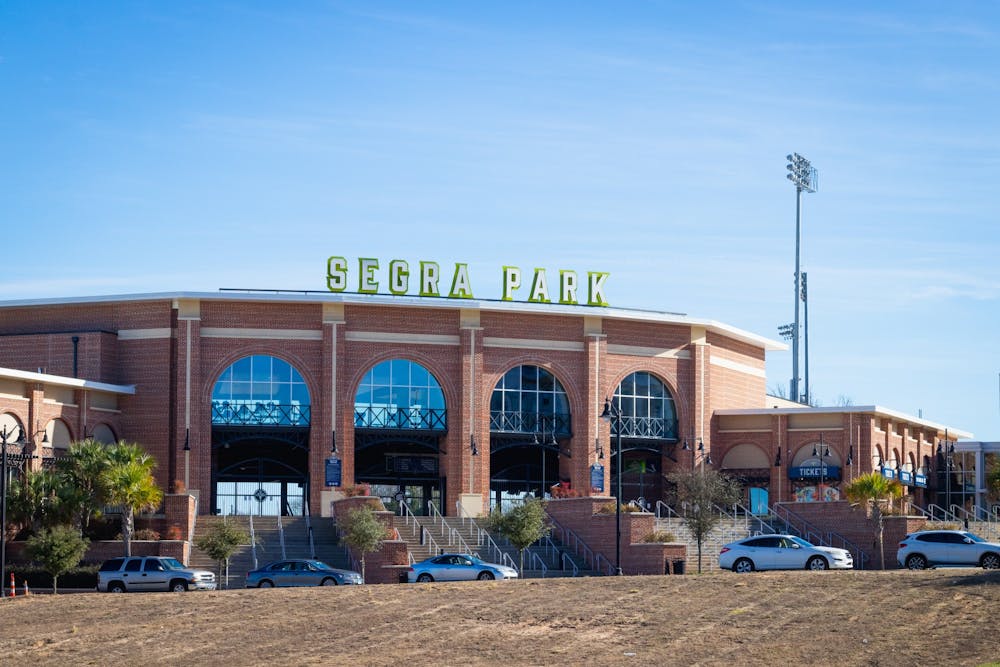In many professional sports markets, relationships between teams and communities are built over generations. Yankees fans have spent many summers on Bronx-bound trains. Bulls supporters have worn Jordan jerseys for decades. Passionate Gamecocks have perpetually packed Williams-Brice Stadium from September to November each year. While such an environment may seem hostile to fledgling franchises, it allows new teams to create their own identity and market it to the public. For the Columbia Fireflies, Soda City’s seven year old minor league team, a vital part of that identity is the Holiday Lights.
The Holiday Lights is a festive light show that takes place in Segra Park, the team’s stadium. For the event the baseball diamond is decorated with holiday-themed light displays, food vendors, and family-friendly activities. However, the Holiday Lights is also paired with the Six Weeks of Giving initiative, which aims to collect donations for a variety of charities dedicated to helping Columbia’s citizens.
Fireflies president Brad Shank elaborated on the intentions behind the concept. “It was one of those things where we said it's not just about us,” commented Shank. He added that it was necessary for the team to focus on, “building up our community." But for the Fireflies, being involved in the area is more than a method for attracting fans.
Shank claims the team to be a, “community asset,” a term that has defined the Fireflies’ approach to outreach. The team’s staff have made many efforts to improve Columbia, ranging from refurbishing overgrown Little League fields to lighting fireworks for patients in the Prisma Health Children’s Hospital.
Additionally, the team’s presence has led to large economic growth in the Bull Street District. Shank estimates that 700 million dollars have been invested in development around Bull Street since the team’s arrival, creating a multitude of new jobs. All of these impacts have a clear purpose. In the words of Shank, the Fireflies, “want the community to love the team,” and outreach is another way of earning that love.
In many of America’s major sports markets, team-city relationships are much more fraught. Many problems arise from funding policies, as it is commonplace for local governments to subsidize stadium construction. These funds usually come from tax revenue, a move that often causes controversies. Such a situation is currently playing out in the state of New York. Governor Kathy Hochul recently approved an 850 million dollar subsidy for the Buffalo Bills’ new stadium, angering many residents in the process. Critics blasted Hochul for not using the money to fund other services such as welfare and education. Underlying all of this criticism was a similar idea; the Bills were not providing enough to Buffalo to warrant such a sizable investment.
Shank was quick to mention the Fireflies’ own history with stadium funding. Segra Park was largely subsidized by out-of-market hospitality taxes, which typically come from tourist spending. This move ensured that minimal amounts of taxpayer dollars were spent on the facility itself. Additionally, the Fireflies’ management created a team-financed fund dedicated to maintaining the stadium, meaning that the city wouldn’t have to contribute money for repairs. By alleviating the monetary burdens placed on taxpayers, the Fireflies were able to fund Segra Park without causing large-scale controversy.
The Fireflies earn respect through more than just financial planning, however. A major part of their relationship with Columbia is Segra Park itself. Shank wants the park to be, “a place we want people to love to be,” and many activities are designed around that principle. Segra Park is used throughout the year for baseball games, concerts and seasonal events, all of which keep the stadium active. In fact, one of the Fireflies’ most unique policies is centered around stadium availability. On Mondays through Fridays from dawn until dusk the park is open to the public. Anyone can enter and, as Shank puts it, “have the beautiful setting around them."
Programs like these establish Segra Park as a community space, which has a powerful effect on the city-wide perception of the team. Seeing people enjoy the ballpark is especially rewarding for Shank too.
“The coolest thing is when you have people walk in here and they’ve got family or friends in town visiting and you can hear them talking and saying, ‘Well this is our ballpark,’” he commented. “When they say ‘our ballpark,’ that’s music to my ears because that means they’ve taken ownership of it as well."
Operating Segra Park in a community-centric way is just as much of a responsibility for the Fireflies as their business plans. Shank emphasized how the team has to be great stewards of this gift they have been given by maintaining the stadium and keeping it as a community asset. This management philosophy places what the team does for the city alongside profits, creating a harmony between the team and the citizens.
Upholding this harmony can yield great results. Sports teams can make massive contributions to city culture if they are run well, as evidenced by their popularity in large sports markets. Even Columbia has seen the cultural impact of sports. The city just would not be the same without Williams-Brice looming in the background.
The Fireflies want to host more events like the Holiday Lights to better their relationship with the public. In particular, the team wants to have more multi-day events that will bring people to the ballpark, even when it's not baseball season. These new projects will promote Segra Park’s reputation as a common ground for Columbia, which, alongside the team’s outreach, will further the Fireflies’ mission of being a community-based operation. Hopefully, these efforts will result in the Fireflies becoming another cultural cornerstone for the city of Columbia.



